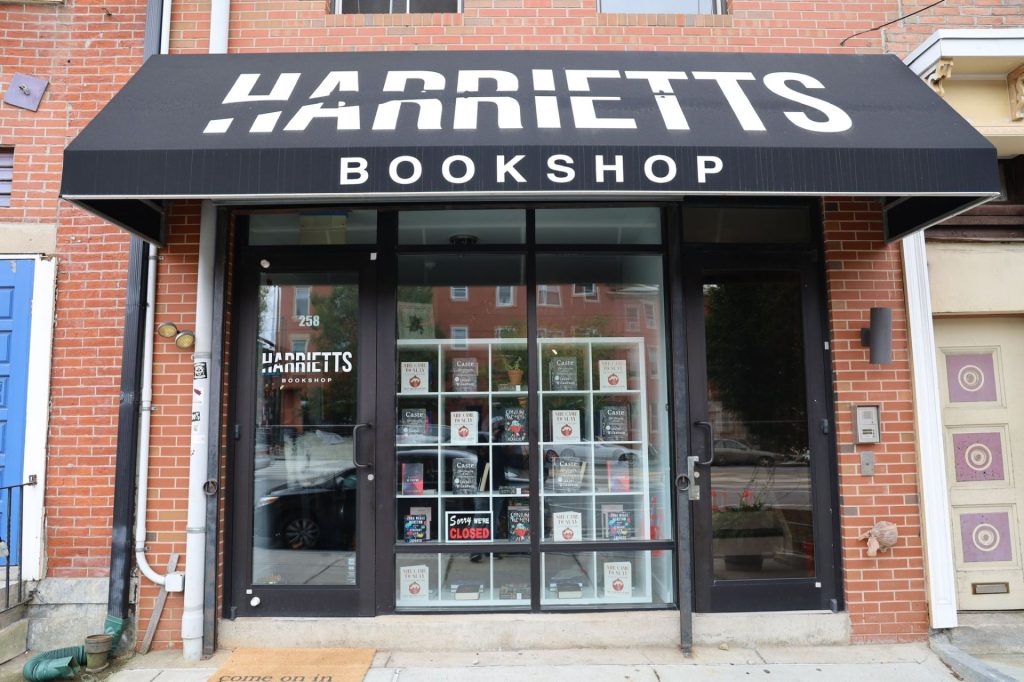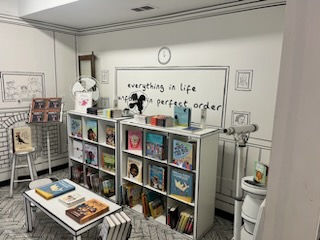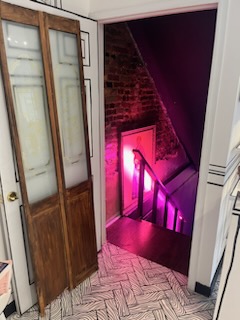Harriett’s Bookshop: A Temple for Black Women
Stepping into Harriett’s Bookshop is to step into a book itself. You will not enter a simple store, you will take a carefully curated journey through Black Women’s literature, culture, and art in the past, present, and future. You will be transported. You will be moved. Most importantly, you will pay homage of the power, merit, and artistic value of Black Women’s Litaerature.

You arrive at Harriett’s Bookshop. First, you will be presented with its cover. There’s the title, the bold lettering of Harriett’s logo on the front eave. The store window is a mosaic of book covers, spaced evenly in square cubicles like little stages (Buzbee, 121). Immediately you know that this is a place that values the book to a degree higher than simple stories, this is a place that presents each cover as art, that carries weight, that buries messages in every corner, just look at that rifle hidden in the store’s very name.

When you open the door, you open to a sea of pages. The walls are paper white, every surface illustrated with thin black lines, creating the illusion of a hand-inked drawing. Everything is outlined in perfect detail, from the chairs and tables to the doors, to the framed illustration of the shop’s namesake—Harriett Tubman– who sits proudly behind the desk counter as if she owns the place herself. Here books are presented as if they are gallery pieces, laid as brilliant spots of color in a blank, white slate of space that gives the books all the attention, all the praise, the dignity and appreciation of classic paintings. You take a deeper look at the honored books in this space, noticing thier placement in the store, noticing thier arrangments. You should instantly recognise the emphasis of Black Women authors, thier names in bright, bold lettering, thier faces on bookcovers and framed on the walls. If bookstores are places that attempt to define the culture understanding of “literature,” then Harriett’s makes a bold statement about the worth and value of Black Women within that definition. Harriett’s is a place where Black Women’s literature is given the full floor plan of the store. It challenges and scorns the idea that “the ‘beauty’ of much Non-Western ‘art’ is a recent discovery,” (Clifford, 227) and calls these marginalized works of past and present into the foreground of the defintions of literature and culture. It is important to keep in mind the social and cultural weight of centering these voices as you move through the rest of the store. The collection of books within Harriett’s “seems to be seeing through them into their distant past as though inspired” (Buzbee, 61) by the compelling history of marginalization of Black Women, drawing these histories out of the objects themselves by thier careful placements and orderings. You will notice in many authors’ biographies that they are local writers of color, local women, dedicated to the preservation of their identities in the literary sphere. You will also inevitably come across the works of Harreitt’s self-described “founding fore-mothers” of Black Literature: Zora Neale Hurston, Octavia Butler, Alice Walker, and Toni Morrison.
Below: The same shelf across several months. Notice that the displays are only for 2-5 different books, repeated again and again



Books in Harriett’s are spotlit, given space in the way you would expect to see in a museum space. Quotes from famous Black women and men are literally framed on the walls, as if to say “here, you will take these words as the art that they are.” You’ll find quotations from Maya Angelou, Langston Hughes, and Nikole Hannah-Jones. All of these greats meet you at the start of the store, and stay with you as you browse. The shevling will be different every time you visit. The space is designed to be multipurpose. The openness of the floorplan, and the shops constant physical rotations means it is often home to readings, musical events, book signings, book club meetings, dances, even mimosa nights. Harriett’s welcoming aura created by their frequent hosting negates the traditional stuffiness of a museum space, simulatenously honoring literature and humbling literature, offering literature to everyone. The light, white cubes and tables change in location, number, and size based on which book is currently “on exhibit.” Owner and curator, Jeanine Cook, creates intricate displays of literature that rotate frequently, completely changing the layout of the interior shelves to spotlight certain novels. An excellent example of just such an exhibit is the recent promotion of The 1619 Project, a long-form journalitic book written by Nikole Hannah-Jones. Jones visited the shop many times during the promotion of her book, forming a relationshp with owner Jeanine Cook, a “sisterhood.”

When books like 1619 project are featured, they consume the store, showing up in repitions or taking up enture cubicle walls as if to chant the title of the book again and again. This contrasts to the classic “books in piles on the floor” aesthetic that you expect from a indie bookstore, replacing it with deep reverance, a sort of holy space for book to be appreciated, worshipped, inacted. Harriett’s creates here “the most profound enchantment for the collector…the locking of individual items within a magic circle in which they are fixed,” (Buzbee, 60) as the books are repeated and repeated again, held up as pieces of a mosaic tiled artpiece, each book coming together to tell a great story.

In the back of the first floor, there are two permanent and beloved fixtures: the children’s section and the Reading Garden. The children’s section of Harriett’s is given a large, roomy area with low chairs and a schoolhouse theming painted onto the walls. Unlike the other, rotating shelves, this area is consistant, always featuring children’s books about women, black women, and black children. Where the main body of the store feels like a gallery, this space feels warm, small, more cluttered, like a children’s playspace. Mantras are repeated on the walls and titles of the books: Black is beautiful, the world is yours, Black girl magic. This area is made to welcome children, provide for them a place full of literature designed for them.

Between the reading garden and the children’s section, there is a door leading to the basement of the store, what Cook calls The Underground.
In the Underground, the lights are low and patrons are encouraged to use candles to traverse the book shelves with, paying homage to those Black readers of the past who had to hide to read. In yet another contrast, the basement feels like a dark club, something Harriett’s plays off of with thier fun and funky Book “Clubs” hosted in the basement’s moody neon lighting, paired with music and lightly boozy refreshments. At the bottom of the stairs is a shrine dedicated to Harriett, affirmations in neon light, candles lit and unlit.

Along the walls are highly specified, unlabeled categories of gently used books. Books are grouped by sections as specific as: Black magical realism, memoirs about being Black and Queer, books about the underground railroad, Star Trek, slice-of-life fiction set post Civil War, the Harlem Renaissance, women in politics, and more. Refusing to lavel these niches, referencing the underground railroad in the name of the space, the shrines, all of these things pay subtle homage to Black culture. They offer themselves to patrons with a wink and a nod, a IYKYK mentality that Harriett’s seems to thrive with.
Harriett’s Bookshop is a space to give honor, artistic worth, and deep reverence to the works of women of color. Whether it be an art gallery, a smoky club, or a cozy schoolroom, Harriett’s embodies the envirornments that Black Women are marginalized in, and uplifts them, centers them. Jeanine Cook has made this honoring of Black art her life’s work. Harriett’s carries on its back the intense history of a movement towards Black Literature’s respect and value. Harriett’s demonstrates the idea that “inheritance is the soundest way of acquiring a collection,” (Benjamin, 66) as it attmepts to collect the long and star-studded history of the cultures it honors. Cook’s highly developed curation within Harriett’s displays that “the most distinguished trait of a collection will always be its transmissibility,” (Benjamin, 66) it’s ability to continue on with a momentum that transends the simple structure of the bookshop it inhabits.
Citations:
Benjamin, Walter. Illuminations : Essays and Reflections. Boston ; New York, Mariner Books, Houghton Mifflin Harcourt, 2019.
Buzbee, Lewis. The Yellow-Lighted Bookshop. ReadHowYouWant.com, 19 Oct. 2010.
Clifford, James. The Predicament of Culture : Twentieth-Century Ethnography, Literature, and Art. Cambridge, Mass., Harvard University Press, 1988.

0 Comments